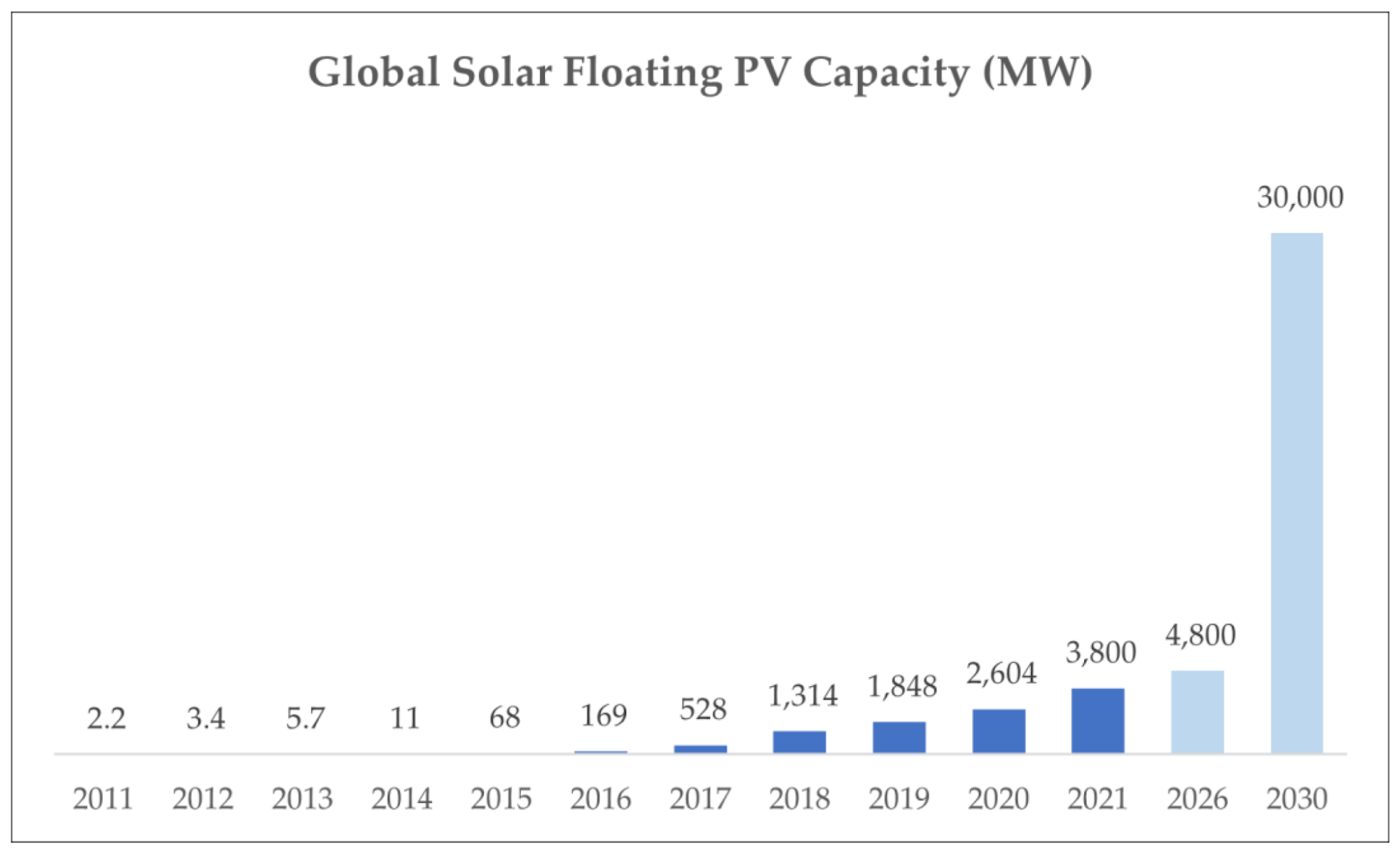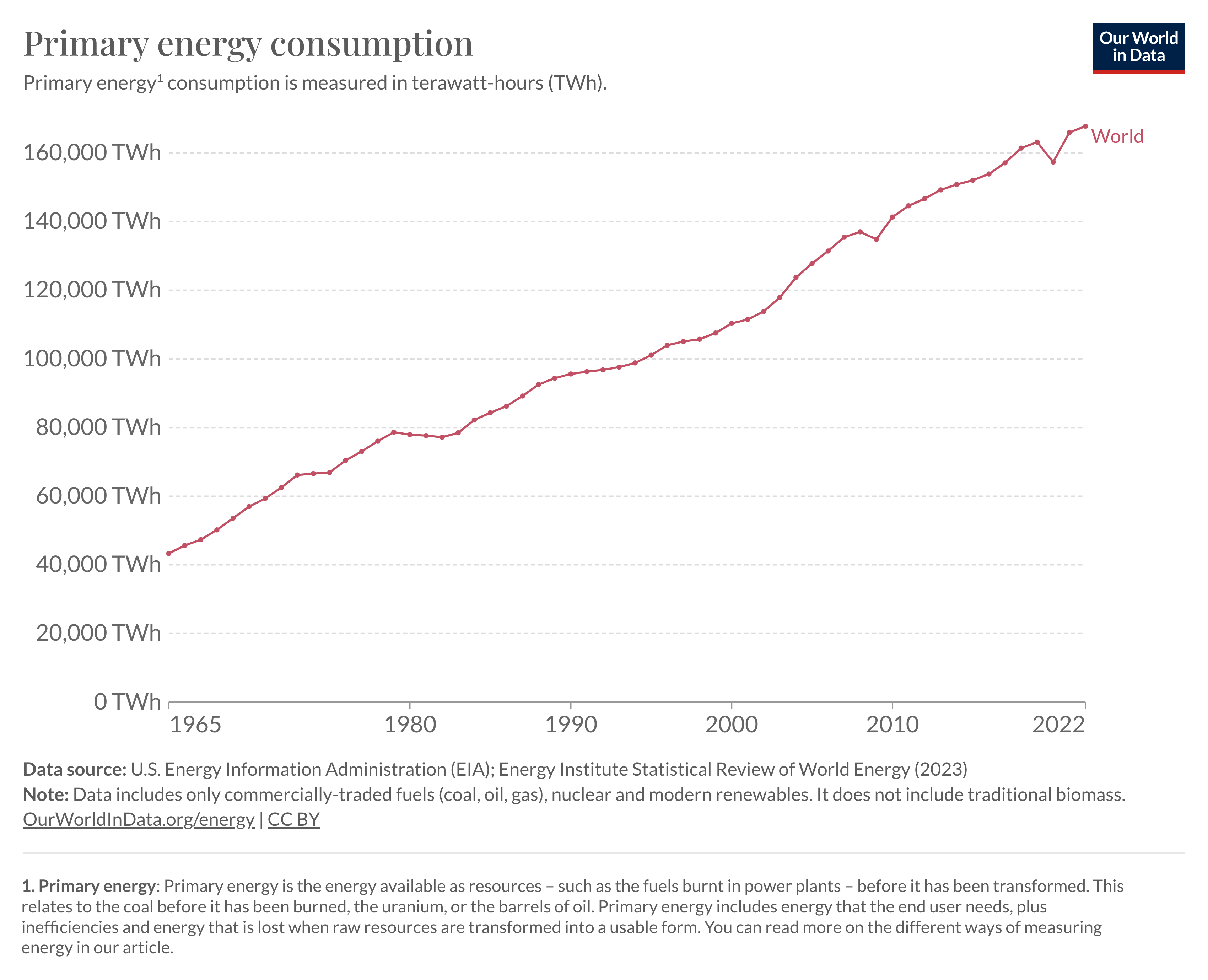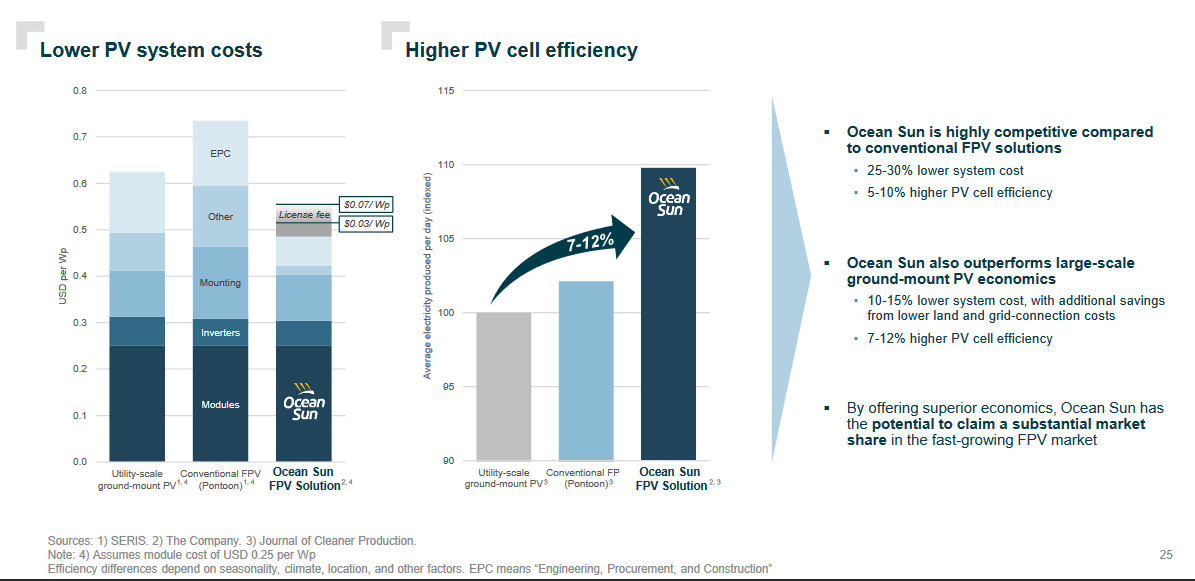What’s stopping us from converting the open ocean into a massive solar power plant? To the tune of almost 6 times more energy than the world uses every year. Several companies are trying to do just that by floating solar panels out on the open ocean, but that raises so many questions. Won’t they get smashed to pieces during storms? Why even bother with the ocean when we have land? Developing seaworthy panels is a lot more complicated than just smashing a bottle on the array and setting sail.
So, what makes floating photovoltaics on the ocean worth a shot? And what’s holding it back?
When news about companies like HelioRec and Ocean Sun bubbled up about putting solar panels out on the ocean, it really caught my attention. This wasn’t theoretical, but really happening. Initially, I thought: “How is that going to work and not get torn apart by storms?” My gut reaction was that the engineering and maintenance challenges felt insurmountable and the cost would be too high. So my team and I started diving into the world of floating solar again to see if we could find answers to those questions. If we can keep turbine towers that are taller than national monuments afloat, why can’t we throw a solar panel array into the deep end of the earth’s pool? What we found was fascinating … but also raised as many new questions as it answered.
I’ll get to HelioRec and Ocean Sun in a minute, but there’s a big question we have to answer first: Does floating solar on water even make sense?
To answer that question, we’ll have to start inland. Floating photovoltaics, or floatovoltaics, is a relatively new branch of the solar industry. Its global installed capacity only started to expand beyond 1,000 MW around 2018.1 But the technology has become more common over the past few years with about 3.8 GW installed by 2021.1 That’s a tiny sliver of the thousands of GW of solar installed worldwide.2

If you’ve been following the channel for a while, you might remember last year’s video about floating solar on canals. In case the concept is unfamiliar to you, though, know that floating PV (FPV) is exactly what it sounds like: solar panels moored within a body of water. FPV has three major benefits:
Floating solar farms aren’t occupying limited space on land.
Solar panels on water stay cooler, and therefore perform better.
Bodies of water shielded by FPV are less prone to evaporation, which helps preserve freshwater supplies.
These perks are the basis for ongoing projects in places like the United States and India, where miles of canals are being used to determine if FPV is a boon…or boondoggle. For more details on that, check out that video.
It’s that second benefit, about solar performing better on water, that’s really fascinating. One of the largest solar farms in Europe is a great example. EDP, a Portugal utility, built floating solar on the country’s Alqueva reservoir. It’s not exactly a choppy ocean, but still important to understanding what we can get out of FPV. According to Pedro Oliveira, the company’s Director of Innovation, its FPV farm has seen increased efficiency thanks to water’s cooling effect. He cites an efficiency increase of “up to 10%” along with an average annual productivity increase of around 4%.3 Adding on to that, a separate 2021 ENEL Innovation Lab FPV study found that floating systems can produce anywhere from 4% to 7% more energy than ground-based solar.4 Keep these FPV benefits in mind as we work through the challenges, and what HelioRec and Ocean Sun are trying to do out at sea.
So, if FPV is already an emergent use of canals, lakes, and artificial reservoirs, we can definitely apply the same tech to the ocean, right? Well, not exactly.
What’s different about floating panels on the ocean? Well, it’s kind of like the distinction between tap water and seltzer. Unlike the mostly still surfaces of the previous examples, the ocean would of course be constantly churning and bombarding the panels with salt. Exposure to all that salty water leaves the panels at risk of corrosion. More movement means more money spent designing reinforced frames and mooring strong enough to stay afloat. It also means risk of sunlight spreading unevenly across the panels, which lowers energy production.51
Ensuring that the panels are close enough to the water to be cooled, but not too close to be overwhelmed by the waves, is yet another delicate balancing act. Plus, while the sun-blocking element of freshwater FPV can slow down algae blooms and weed growth, marine fouling is literally a whole different animal. Just like offshore wind, offshore solar structures will also act as artificial shelters for aquatic life, adding another dimension to the challenges. Where there’s fish, there’s birds, and where there’s birds, there’s bird droppings. Not exactly great for solar panels. We also can’t forget that the potential negative impacts on the local ecosystems are still unclear. Ultimately, as nice as it would be to plop freshwater FPV into the ocean and call it a day, it’s simply…not that simple.51
Not to mention the weather. Florida hurricanes, for example, would not be kind to FPV. In fact, a study published this past June suggests that the majority of countries are knocked out of the running for practical installation of offshore solar. According to The Australian National University researchers, that’s because “most of the world’s maritime areas have experienced waves larger than 10 m [33 ft] and wind speeds larger than 20 m/s [45 mph] at some time over the past 40 years.” These conditions are not only linked — in general, more forceful winds mean more powerful waves — but can also seriously damage FPV system components like floats and cables.156
A dangerous example of this happened back in 2019, when Typhoon Faxai’s 54 m/s (120 mph) winds actually caused a Japanese floating solar plant to go down in flames. Keep in mind that this was an inland system installed on top of the Yamakura Dam. As the wind and waves flung panels together, they overheated in close contact and sparked a fire.67 The study authors argue that in places where tropical storms can occur, engineering defenses against incidents like these could be prohibitively expensive.1
Where does that leave offshore FPV? Don’t worry: there’s still plenty of places with calm waters that can theoretically accommodate photovoltaic pontoons. After analyzing 40 years’ worth of weather data on wind speed and wave height, the Australian research team determined that the best locations for floating panels lie within the planet’s equatorial zones, like in Southeast Asia and Northwestern Africa. The researchers emphasize the Indonesian archipelago and the Gulf of Guinea, which is off the coast of African countries Nigeria and Cameroon, as prime examples.1
So, what makes these sites so special? Why are their waters calmer? And what about tropical storms? As we researched this topic, it’s at this point when I turned to a member of my channel’s science advisory board, meteorologist and storm chaser Seth Price. He explained that to answer these questions, all we have to do is look at the shape of a globe.
Our big blue marble happens to be wider at the Equator. Consequently, as Earth rotates, its middle is actually moving faster than its poles. This is what causes what’s known as the Coriolis Effect, or the curving movement of water and air as they move over the planet’s surface. The Coriolis Effect is what makes storms spin. At the Equator, there is no Coriolis force, so tropical storms virtually never form there — or cross its bounds.8 Seth also added that because these physics are based on the Earth’s rotation, they won’t change even as the climate does. That’s particularly important to note in light of the concerns about how to adapt marine FPV to new weather patterns.9 It’s already hard enough to design materials that can survive years of battering by the elements. Having to consider the risk of extreme and unprecedented weather events doesn’t make things easier.5
Does the Equator’s protective barrier mean that offshore FPV is ironclad in those regions? Of course not — otherwise we’d probably be used to seeing solar panels bobbing on the waves by now. As Seth says,
“There will always be a natural scenario to destroy even the best-engineered project.”
Wise words, Seth. Wise words. However, he also pointed out that we’re already long-accustomed to resilient energy generation on the ocean’s surface…in the form of oil rigs, and more recently, floating wind turbines. Norwegian petroleum company, Equinor, created the first offshore wind farm in 2017 using the same spar platforms that are ubiquitous in the oil and gas industry.1011 Developing technology that can weather storms, constant wave action, sea spray, and the harsh UV rays emanating from the sun is complex … but far from impossible. In fact, it’s likely that we can reap the same benefits of pairing wind and solar that we get on the ground out in the ocean: sharing grid infrastructure and operational equipment can keep costs down and combat intermittency.5
Is it worth the trouble, though? The Australian National University research team certainly seems to think so. In that paper I mentioned earlier, its authors go as far to say that the eligible equatorial regions they highlighted enable “huge” energy generation potential for FPV:1
“The combined offshore floating solar PV annual generation potential for regions that do not experience waves larger than 4 m [13 ft] or winds stronger than 15 m/s [33.5 mph] is 220,000 TWh. This is sufficient for all the energy needs of an affluent global population of 11 billion people.”
But that’s not all. The researchers propose that if marine FPV can survive maximum wave heights of 6 meters (19 feet), the annual energy generation potential jumps up by a lot. To the tune of a collective production of up to one million TWh per year.1 To put these figures into perspective, Our World in Data lists the planet’s annual primary energy consumption (that’s from all sources) at 167,788 Twh in 2022.1213141

So who’s out there actually testing the waters? There’s more offshore solar farms currently in operation than you might think.
In Indonesia, the country’s Sepuluh Nopember Institute of Technology and Pattimura University are collaborating with researchers at the Cranfield University in England to develop offshore floatovoltaics as part of the Solar2Wave project. According to Luofeng Huang, a mechanical engineering lecturer at Cranfield’s Centre for Energy Engineering, analysis of the team’s designs has shown that they can tolerate waves up to 5 meters (16 feet) high.14
There’s also the Norway-based company Ocean Sun. Taking inspiration from the Victoria Amazonica giant water lily and aquaculture, they’ve developed a design with a thin, flexible membrane that’s stable enough for technicians to walk on.15 The company has installed multiple FPV projects along the western coast of its home country, in the Yellow Sea near Shandong, China, and down the Johor Strait between Malaysia and Singapore. Its first prototype, a 6.6 kWp system commissioned by Norwegian company Lerøy SeaFood for its fish farm, has been kicking since the summer of 2018.1617 Ocean Sun also has plans underway to drop anchors in Greece, Cyprus, and Singapore this year.18
Interestingly, according to the company’s website, its products feature a boost of up to ~10% in energy yield relative to other floating systems as a result of the surrounding water’s cooling effect. To back up that claim, it cites certification by the Singapore office of the energy consultancy agency DNV and a study conducted by Norway’s Institute for Energy Technology.1920 It also goes as far to say that the cooling is consistent enough to prevent the panels from experiencing daily thermal cycling, which basically means that they’re not constantly bouncing between high and low temperatures.20 Ocean Sun’s floaters can also withstand wind speeds as high as 275 km/h (171 mph).21 That’s impressive.
Then there’s the French company HelioRec, which recently announced the successful installation of a 25kW pilot system in the port city of Brest. According to the company website, the location is significant because of its notoriously high wind speeds of over 100 km/h (62 mph)…and high tides, which can swell up to 7 meters (23 feet).22 And to date, HelioRec’s 10 kWp system at the Port of Oostende in Belgium has managed to survive two storms.23
Perhaps most critically, though, is what we know about the costs…or rather, what we don’t know. In a 2020 Ocean Sun investor presentation, the company claims that its systems are between 25% and 30% cheaper than conventional FPV, and 10% to 15% cheaper than ground-mounted PV.24 And per its 2023 Second Quarter & Half Year report, its equipment costs are “closer to that of ground-mounted PV.”25

What Ocean Sun advertises as a 25% lower capital expenditure or CAPEX cost partly comes from the fact that its floaters can be easily rolled up, kind of like a beach umbrella.26 This allows them to be transported in a single 40 ft. (12 m) shipping container, which the company says reduces the amount of money spent on logistics.15 But when it comes to any more explicit information than that, data like the Levelized Cost of Electricity (LCOE) isn’t clearly stated on the company website. The most detail we get comes in the form of the claim that Ocean Sun’s floaters have the “overall lowest material usage of any floating PV system, enabling the lowest overall LCOE.”27 We’ll have to take that with a grain of sea-salt until we can see more independent data.
What we do know for sure is that as it stands, offshore solar is very new. The projects we’ve discussed so far are not only experimental and small in scale, but relatively “near shore.” Until the technology matures, we won’t be skimming sunshine off the waves of the open ocean just yet.5
Overall, it’s less about what’s possible and more about what’s practical. The same strategies used by the oil and gas industries to maintain floating drilling operations have already been applied to renewables in the form of offshore wind. Meteorological research indicates that areas near the Equator are probably offshore solar’s best bet. Resources exist to meet the concept’s design challenges, but is it ultimately worth the cost — and the potential ramifications for aquatic life? We’ll have to “sea” about that.
- Global Atlas of Marine Floating Solar PV Potential ↩︎
- Cumulative installed solar PV capacity worldwide from 2000 to 2022 ↩︎
- Are floating solar farms the future of clean energy? – BBC News ↩︎
- Analysis of water environment on the performances of floating photovoltaic plants ↩︎
- Marine floating solar plants: an overview of potential, challenges and feasibility ↩︎
- Testing the waters with floating solar plants ↩︎
- Typhoon Faxai Destroys Japan’s Biggest Floating Solar Plant ↩︎
- The Coriolis Effect: Earth’s Rotation and Its Effect on Weather ↩︎
- Offshore floating solar on calm seas could provide unlimited energy ↩︎
- Hywind Scotland ↩︎
- Floating offshore wind ↩︎
- Energy – Our World in Data ↩︎
- Could floating solar farms survive out at sea? ↩︎
- The potential of floating solar power in Indonesia ↩︎
- Ocean Sun Benefits ↩︎
- Ocean Sun | Skaftå ↩︎
- Admission Document ↩︎
- Ocean Sun Projects ↩︎
- Ocean Sun Products ↩︎
- Frequently Asked Questions ↩︎
- Floating solar | Banja pilot system 2022 ↩︎
- Floating solar in Brest Port ↩︎
- HelioRec portfolio ↩︎
- Ocean Sun | Investor Presentation ↩︎
- Ocean Sun Second Quarter & Half Year Report: 2023 ↩︎
- Ocean Sun | Investor Story ↩︎
- The Innovation ↩︎















Comments